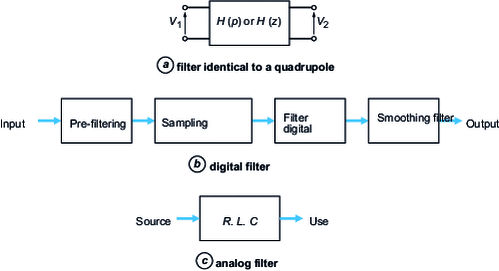Overview
ABSTRACT
With the large number of filters available, filtering is one of the most frequently used functions in electronic systems. Whether it be attenuation or phase correction, the filter has a function assimilable to signal processing, the useful signal being sent through a set of electronic circuits that modify the frequency spectrum and/or its phase. The goal of filtering is to extract a part of the information in order to render a more intelligible signal. The electric filter changes an input electrical signal into an output electrical signal. This article reviews and compares the different types of existing filters (e.g., digital, analog, passive, switched capacitors), with outcomes and characteristics.
Read this article from a comprehensive knowledge base, updated and supplemented with articles reviewed by scientific committees.
Read the articleAUTHORS
-
Gaëlle LISSORGUES: Professor at ESIEE, associate professor of applied physics - Alumnus of the École normale supérieure de Cachan
-
Henri FÉLIX: engineer from the École nationale supérieure de l'aéronautique et de l'espace and former coordinator of the Esprit and Eureka cooperation projects at Bull SA, published in 1997.
INTRODUCTION
Filtering, which consists in isolating a frequency band from a complex signal, is one of the most widely used functions in electronic assemblies and signal processing. Most electronic systems include a large number of filters to meet a wide variety of functional requirements.
In very general terms, filtering is a form of signal processing, obtained by sending the useful signal through a set of electronic circuits, which modify its frequency spectrum, and/or its phase, and therefore its shape (figure 1 ). The purpose of filtering is to extract part of the information associated with this signal, or more often, to restore a more intelligible signal from an incident signal, in terms of the information it contains and which we wish to select. This may involve eliminating or attenuating unwanted interference frequencies, or isolating the useful frequency band(s) in a complex signal.
Finally, an electrical filter effects a change from an electrical input signal, for example a voltage v 1 (t), to an electrical output signal, namely a voltage v 2 (t). To the modification of the time signal v 1 (t) corresponds a modification of the spectrum V 1 (jω) to produce a new spectrum V 2 (jω) associated with the signal v 2 (t).

Exclusive to subscribers. 97% yet to be discovered!
You do not have access to this resource.
Click here to request your free trial access!
Already subscribed? Log in!

The Ultimate Scientific and Technical Reference
This article is included in
Electronics
This offer includes:
Knowledge Base
Updated and enriched with articles validated by our scientific committees
Services
A set of exclusive tools to complement the resources
Practical Path
Operational and didactic, to guarantee the acquisition of transversal skills
Doc & Quiz
Interactive articles with quizzes, for constructive reading
Filtration and electrical filters
Bibliography
Works
Software
(non-exhaustive list)
SPICE (Simulation Program with Integrated Circuits Emphasis), MicroSim Corporation
Electronic circuit simulation software developed at the University of California since 1975 http://bwrc.eecs.berkeley.edu/Classes/IcBook/SPICE
ADS (Advanced...
Exclusive to subscribers. 97% yet to be discovered!
You do not have access to this resource.
Click here to request your free trial access!
Already subscribed? Log in!

The Ultimate Scientific and Technical Reference